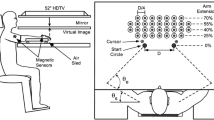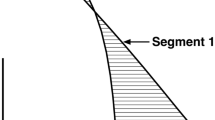Abstract
Recent studies have shown that patterns of endpoint variability following double-step reach sequences reflect the influence of both planning and execution-related processes, but are strongly dominated by noise associated with the online updating of movement plans based on visual feedback. However, it is currently unclear whether these results reflect the dominant arm/hemisphere’s postulated specialization for visual feedback processing, or whether these effects reflect a more general “arm/hemisphere independent” preference for visual feedback in the control of reaching. To explore this, twelve subjects performed double-step reach sequences with their dominant and non-dominant arms to targets in 3D space with and without visual feedback of the arm. Variability was quantified using the volumes, aspect ratios, and orientations of 95 % confidence ellipsoids fit to the distributions of reach endpoints. In consonance with previous findings, the availability of visual feedback resulted in ellipsoids that were significantly smaller, had greater aspect ratios, and were more aligned with the depth axis than those performed without visual feedback. Moreover, the effects of vision on aspect ratio and orientation were similar in magnitude for the dominant and non-dominant arms, suggesting that noise associated with planning and execution-related processes is managed in a similar way by the sensorimotor systems of each arm. However, the degree to which vision decreased ellipsoid volume was found to be significantly greater for the dominant arm. This suggests that the feedback control system of the dominant arm uses visual information more efficiently to control reaches to visual targets.




Similar content being viewed by others
References
Apker GA, Buneo CA (2012) Contribution of execution noise to arm movement variability in three-dimensional space. J Neurophysiol 107:90–102. doi:10.1152/jn.00495.2011
Apker GA, Darling TK, Buneo CA (2010) Interacting noise sources shape patterns of arm movement variability in three-dimensional space. J Neurophysiol 104:2654–2666. doi:10.1152/jn.00590.2010
Carrozzo M, McIntyre J, Zago M, Lacquaniti F (1999) Viewer-centered and body-centered frames of reference in direct visuomotor transformations. Exp Brain Res 129:201–210
Carson RG, Goodman D, Chua R, Elliott D (1993) Asymmetries in the regulation of visually guided aiming. J Motor Behav 25:21–32
Contreras-Vidal JL, Buch ER (2003) Effects of Parkinson’s disease on visuomotor adaptation. Exp Brain Res 150:25–32. doi:10.1007/s00221-003-1403-y
Faisal AA, Wolpert DM (2009) Near optimal combination of sensory and motor uncertainty in time during a naturalistic perception-action task. J Neurophysiol 101:1901–1912
Faisal AA, Selen LPJ, Wolpert DM (2008) Noise in the nervous system. Nat Rev Neurosci 9:292–303
Flowers K (1975) Handedness and controlled movement. Br J Psychol 66:39–52
Goble DJ, Brown SH (2008a) The biological and behavioral basis of upper limb asymmetries in sensorimotor performance. Neurosci Biobehav R 32:598–610. doi:10.1016/j.neubiorev.2007.10.006
Goble DJ, Brown SH (2008b) Upper limb asymmetries in the matching of proprioceptive versus visual targets. J Neurophysiol 99:3063–3074. doi:10.1152/jn.90259.2008
Goble DJ, Brown SH (2010) Upper limb asymmetries in the perception of proprioceptively determined dynamic position sense. J Exp Psychol-Hum L 36:768–775. doi:10.1037/a0018392
Goble DJ, Noble BC, Brown SH (2009) Proprioceptive target matching asymmetries in left-handed individuals. Exp Brain Res 197:403–408. doi:10.1007/s00221-009-1922-2
Gordon J, Ghilardi MF, Ghez C (1994) Accuracy of planar reaching movements. 1. Independence of direction and extent variability. Exp Brain Res 99:97–111
Haggard P, Newan C, Blundell J, Andrew H (2000) The perceived position of the hand in space. Percept Psychophys 62:363–377. doi:10.3758/bf03205556
Hermsdorfer J, Goldenberg G (2002) Ipsilesional deficits during fast diadochokinetic hand movements following unilateral brain damage. Neuropsychologia 40:2100–2115
Khachiyan LG (1996) Rounding of polytopes in the real number model of computation. Math Oper Res 21:307–320
Khachiyan LG, Todd MJ (1993) On the complexity of approximating the maximal inscribed ellipsoid for a polytope. Math Program 61:137–159
Knecht S, Drager B, Deppe M et al (2000) Handedness and hemispheric language dominance in healthy humans. Brain 123:2512–2518. doi:10.1093/brain/123.12.2512
Longstaff MG, Heath RA (2006) Spiral drawing performance as an indicator of fine motor function in people with multiple sclerosis. Hum Mov Sci 25:474–491. doi:10.1016/j.humov.2006.05.005
McIntyre J, Stratta F, Lacquaniti F (1997) Viewer-centered frame of reference for pointing to memorized targets in three-dimensional space. J Neurophysiol 78:1601–1618
McIntyre J, Stratta F, Lacquaniti F (1998) Short-term memory for reaching to visual targets: psychophysical evidence for body-centered reference frames. J Neurosci 18:8423–8435
McIntyre J, Stratta F, Droulez J, Lacquaniti F (2000) Analysis of pointing errors reveals properties of data representations and coordinate transformations within the central nervous system. Neural Comput 12:2823–2855
Morrison D (1990) Multivariate statistical methods. McGraw-Hill, Singapore
Oldfield RC (1971) The assessment and analysis of handedness: the Edinburgh inventory. Neuropsychologia 9:97–113
Rincon-Gonzalez L, Buneo CA, Tillery SIH (2011) The proprioceptive map of the arm is systematic and stable, but idiosyncratic. PLoS One 6. doi: e2521410.1371/journal.pone.0025214
Roy EA, Elliott D (1986) Manual asymmetries in visually directed aiming. Can J Psychol-Rev Can De Psychol 40:109–121. doi:10.1037/h0080087
Roy EA, Elliott D (1989) Manual asymmetries in aimed movements. Q J Exp Psychol Sect A-Hum Exp Psychol 41:501–516
Sainburg RL (2002) Evidence for a dynamic-dominance hypothesis of handedness. Exp Brain Res 142:241–258. doi:10.1007/s00221-001-0913-8
Salmaso D, Longoni AM (1985) Problems in the assessment of hand preference. Cortex 21:533–549
Sober SJ, Sabes PN (2003) Multisensory integration during motor planning. J Neurosci 23:6982–6992
Sober SJ, Sabes PN (2005) Flexible strategies for sensory integration during motor planning. Nat Neurosci 8:490–497
Thies SB, Tresadern PA, Kenney LP, et al (2009) Movement variability in stroke patients and controls performing two upper limb functional tasks: a new assessment methodology. J Neuroeng Rehabil 6. doi: 10.1186/1743-0003-6-2
van Beers RJ, Sittig AC, van der Gon JJD (1998) The precision of proprioceptive position sense. Exp Brain Res 122:367–377
van Beers RJ, Sittig AC, van der Gon JJD (1999) Integration of proprioceptive and visual position-information: an experimentally supported model. J Neurophysiol 81:1355–1364
van Beers RJ, Haggard P, Wolpert DM (2004) The role of execution noise in movement variability. J Neurophysiol 91:1050–1063
Wilson ET, Wong J, Gribble PL (2010) Mapping proprioception across a 2D horizontal workspace. PLoS One 5. doi: 10.1371/journal.pone.0011851
Acknowledgments
Support for this study was provided by National Science Foundation Grant IOS-0746398.
Author information
Authors and Affiliations
Corresponding author
Rights and permissions
About this article
Cite this article
Apker, G.A., Dyson, K., Frantz, G. et al. Efficiency of visual feedback integration differs between dominant and non-dominant arms during a reaching task. Exp Brain Res 233, 317–327 (2015). https://doi.org/10.1007/s00221-014-4116-5
Received:
Accepted:
Published:
Issue Date:
DOI: https://doi.org/10.1007/s00221-014-4116-5




